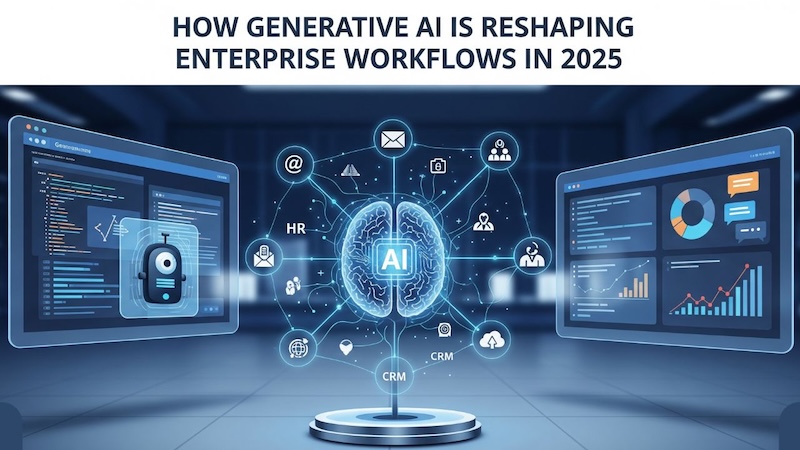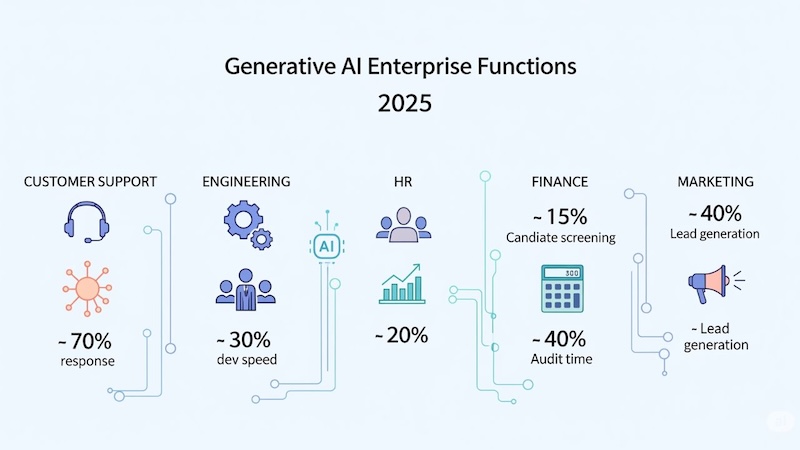How Generative AI Is Reshaping Enterprise Workflows in 2025
Generative AI has moved beyond being a tech buzzword. In 2025, it’s a fundamental part of how modern enterprises operate, reshaping workflows, accelerating productivity, and driving measurable business outcomes. From marketing departments drafting high-converting copy to legal teams generating contracts and finance teams summarizing complex reports, generative AI is quietly becoming the new co-pilot for enterprise professionals.
But how exactly are these changes happening? And what steps should organizations take to ensure they benefit from this transformation?

Why Generative AI Adoption Has Accelerated in 2025
Over the last year, enterprise adoption of generative AI has grown at a staggering pace. Improved model performance, reduced deployment costs, and better security controls have made it easier than ever for organizations to integrate generative AI into their operations.
A recent report from McKinsey & Company noted that more than 70% of businesses are already using generative AI tools across at least one business unit, up from just 30% in 2023. Most commonly, it’s being used in customer service, marketing, and software development, where natural language generation, summarization, and automation offer quick wins.
What’s driving this shift?
- Enterprises now have access to private, fine-tuned models rather than generic ones
- AI integrations with existing tools (like Slack, Notion, or Salesforce) are seamless
- Companies are beginning to see real ROI, both in time saved and costs reduced
In short, generative AI is no longer a theoretical opportunity. It’s a competitive advantage.
Key Enterprise Workflows Being Transformed
Let’s explore the specific areas where generative AI is making the biggest difference across departments.
1. Customer Support and Service
Chatbots have evolved from scripted responders to intelligent, context-aware assistants. They now handle FAQs, refund processing, and even upselling. Enterprises report that AI-enabled chat reduces customer wait times by up to 70% and significantly increases customer satisfaction.
For example, Microsoft’s internal AI systems contributed to $500 million in annual savings, largely due to faster response handling and task automation in support workflows.
2. Software Development and Product Innovation
Generative AI tools like GitHub Copilot have helped developers write, refactor, and test code at incredible speed. Teams report up to 30% faster development cycles, allowing for quicker feature releases and better product experimentation.
Generative AI development in this space is also driving innovation by enabling engineers to rapidly prototype UI, write documentation, or even brainstorm feature specs.
3. HR, Onboarding, and Internal Communications
AI is now being used to generate onboarding materials, internal documentation, and even summarize meetings for absent employees. Companies are using generative AI to reduce time spent on repetitive HR tasks and focus on employee experience.
A pilot study by Deloitte showed that employees saved up to 3 hours per week on internal emails and documentation tasks when using generative AI tools.
4. Finance, Accounting, and Risk Reporting
From automatically generating financial summaries to flagging anomalies in audit logs, generative AI is streamlining complex back-office functions. By converting structured data into readable insights, finance teams can make faster decisions.
JP Morgan Chase has integrated an internal generative AI tool across multiple departments, reportedly boosting advisory productivity and cutting service costs by 30%.
5. Knowledge Management and SOP Creation
Generative AI is helping enterprises summarize large datasets, convert meeting transcripts into action items, and even generate SOPs from scattered documentation. This shift in knowledge work improves operational efficiency and knowledge transfer.

The Role of Generative AI Solutions in Strategic Transformation
While off-the-shelf AI tools offer convenience, many enterprises are moving toward tailored Generative AI Solutions that align with internal processes, data policies, and security frameworks.
These custom-built solutions often come from in-house innovation teams or via strategic partnerships. Generative AI development in enterprise focuses on creating fine-tuned models that understand industry-specific jargon, customer personas, and regulatory boundaries.
Of course, building and scaling AI internally can be complex. That’s where Generative AI consulting firms play a pivotal role. They help enterprises:
- Define a clear AI roadmap aligned with business goals
- Implement responsible AI governance frameworks
- Select the right infrastructure for scale
- Integrate models into existing tools and CRMs
By combining technical expertise with business context, consulting partners accelerate implementation while mitigating risks.
Case Study: Zalando Accelerates Content Creation with Generative AI
One of Europe’s leading fashion platforms, Zalando, recently integrated generative AI into its marketing operations. Previously, the production of visuals for online campaigns took 6–8 weeks. With AI-generated imagery and copywriting, that cycle has been reduced to just 3-4 days, cutting content costs by over 90%.
This enabled their team to launch more localized and personalized campaigns across different markets, driving higher engagement and conversion rates. It’s a real-world example of how generative AI can unlock scale without sacrificing creativity.
How to Safely and Effectively Implement Generative AI
Rolling out generative AI across the enterprise isn’t just about plugging in a new tool. It requires thoughtful planning and stakeholder buy-in. Here’s a recommended workflow:
- Start with one workflow or department with clear goals
- Run a pilot program with a manageable group of users
- Involve both technical and business stakeholders early
- Validate outputs regularly with human oversight
- Establish governance around AI usage, data privacy, and security
- Scale incrementally, measuring ROI at every stage
Security and trust are non-negotiables. Enterprises must ensure that models don’t leak proprietary information or generate biased or incorrect results.
What Challenges Still Exist?
Despite the progress, challenges remain:
- Data Security: Ensuring sensitive data doesn’t leak during inference or training
- Model Bias & Hallucinations: Keeping outputs reliable, especially in customer-facing applications
- Integration Complexity: Aligning AI tools with legacy systems and platforms
- Employee Adoption: Training and change management remain essential
Success in 2025 requires a human-in-the-loop approach, strong leadership, and a willingness to invest in cross-functional AI literacy.
What’s Next: The Future of Enterprise Workflows
Looking ahead, enterprises will see generative AI:
- Embedded directly into tools like Microsoft 365, Salesforce, and SAP
- Powering end-to-end workflows (e.g., generating a campaign and publishing it with zero human input)
- Working alongside robotic process automation (RPA) to handle complex tasks
- Enabling industry-specific assistants that understand legal, medical, or financial domains
Gartner predicts that by 2027, over 50% of enterprise software will include embedded generative AI capabilities.
Final Thoughts
Generative AI is fundamentally changing how work gets done in the enterprise. It’s not about replacing people, but augmenting them, helping professionals do more, faster, and better. The businesses that lean into this transformation will gain a competitive edge not just in 2025, but for years to come.
Whether you’re considering pilot programs or scaling up existing tools, this is the time to think strategically about your organization’s AI journey. With the right Generative AI Solutions, well-planned Generative AI development, and guidance from experienced Generative AI consulting partners, your enterprise can unlock new levels of efficiency and innovation.Now is the moment to lead, not lag.